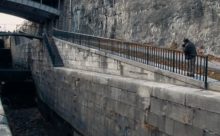Boom and Bust: Native American Perspectives on the Erie Canal
BY CHRISTINE ZINNI, PHD
It is important to acknowledge the other side of the Erie canal story-- and the view of indigenous peoples in the region. The creation of the Erie Canal and the transformation of the landscape throughout the 19th century had profound environmental effects and traumatic consequences on the Haudenosaunee (“People of the Long House”), an alliance of six sovereign Native American nations whose members include the Mohawk, Oneida, Cayuga, Seneca, and Tuscarora nations.
Hotly contested by Seneca Chiefs and their allies, the Buffalo Creek Treaty of 1826 opened up the area along the western terminus of the canal to settlement by Euro-Americans. Displacing thousands of indigenous peoples, the Seneca lost three quarters of their territory or 80,000 acres, including valuable lands near Buffalo Creek in the present day city of Buffalo, the site of which had become a pan-Haudenosaunee center prior to the infamous “treaty” and seat of the Confederacy’s council fire.
Moreover, the rerouting of waters and industrialization wrought by the creation of the canal continues to affect the lifeways of the Onondaga of central New York-- as well as the 450,000 non-natives peoples residing in the water basin of Lake Onondaga. In Haudenosaunee cosmology, water is sacred as fundamental to all life and must be protected. The Erie Canal disrupted the natural flow of water, essentially damning watersheds so as to flow in an east-west direction and rerouting some of the waters of Lake Onondaga, where the Great Peacemaker brought together member nations to create the Law of Peace. The Onondaga Nation’s 21st-century “Vision for a Clean Onondaga Lake” seeks to restore the lake and to make sure that it is clean enough to support the health and well being of fish, waterfowl, animals and humans that inhabit the region. The Onondaga Nation’s 21st-century “Vision for a Clean Onondaga Lake” seeks to restore the lake and to make sure that it is clean enough to support the health and well being of fish, waterfowl, animals and humans that inhabit the region.
